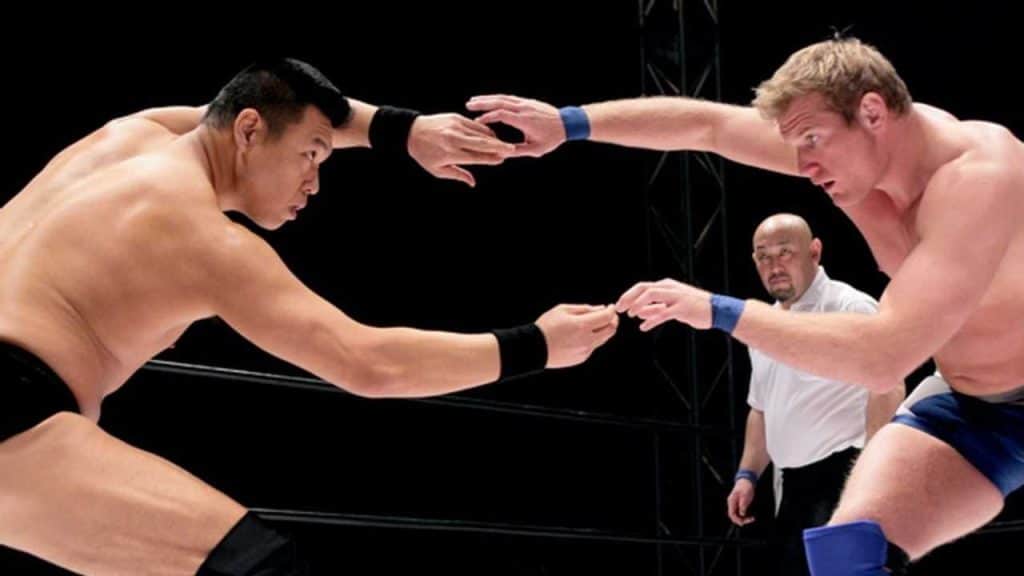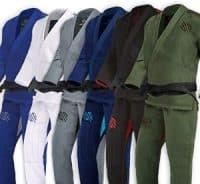Catch wrestling is a style of submission grappling with a heavy emphasis on wrestling. Many have heard of catch wrestling but don’t know precisely what all the grappling art entails.
In this article, we discuss everything that you need to know about catch wrestling. We will look at several aspects, from how this style of submission wrestling was developed to how it has affected modern-day martial arts.
The History of Catch Wrestling

While the exact origin of catch wrestling isn’t known, we do know where the modern version was developed. Below is an overview of the history of modern catch wrestling.
Catch-As-Catch-Can
Today, what we know as modern catch wrestling is based on the catch-as-catch-can style developed by John Graham Chambers. Chambers was a Welsh sportsman famous for being a rower, devising the Queensbury boxing rules, and developing catch-as-catch-can wrestling.
In catch-as-catch-can, wrestlers started on the ground on all fours and competed for dominant positions. They used various tactics to pin opponents by holding their legs and twisting their arms.
In old Lancashire English, the term catch-as-catch-can translates to “catch me if you can.”
Lancashire Wrestling
Catch wrestling started to develop within the Lancashire area of northwest England. Many residents of this area were tough miners who practiced their own wrestling style and were called hookers.
They liked the catch-as-catch-can wrestling style and began implementing their style within it. This included brutal submission holds that could break limbs in multiple places.
Catch Wrestling’s Continued Development
Many catch-as-catch-can practitioners were also members of the British Navy. During their travels around the world, they would pick up different grappling techniques and bring them back to England. This sharing of knowledge would help further continue the development of catch wrestling.
Catch Wrestlers in Carnivals
Like greco-roman-style wrestling, catch wrestlers also worked in traveling carnivals, taking on all challenging spectators in sideshow events.
Since money was on the line and there were few rules, the catch wrestlers had to be well prepared. They practiced many different pins and submissions to finish the fights quickly and stayed in peak condition.
These catch wrestlers had to ensure that no challengers stood a chance against them.
Billy Riley & The Snake Pit
The most influential person in the development of catch wrestling was champion wrestler Billy Riley. Billy was a native of Wigan, Lancashire, and a lifelong wrestler.
He was one of the best “hookers” in an area known for producing the toughest English wrestlers. Riley’s wrestling career lasted for decades, and he would win numerous wrestling titles during this time.
After his competitive career was over, Riley decided to teach catch wrestling back in his home of Wigan. There, he would open the world-famous Snake Pit Catch Wrestling School.
The Snake Pit would produce countless champion wrestlers that would spread catch wrestling across the world. Everyone from Karl Gotch, Bert Assirati, Billy Robinson, and Jack Dempsey.
These catch wrestling champions would pass on what they learned from Billy Riley to the next generation of wrestlers.
Catch Wrestling Today
Today, catch wrestling is still proving that it is one of the most effective grappling styles in the world. This is thanks to the success of modern catch wrestlers like Erik Paulson, Tony Cecchine, and Josh Barnett, who are the style’s top ambassadors.
WARRIOR STRENGTH 12-WEEK PROGRAM
Do you want to win your next fight, transform your body & unleash your potential as a martial artist?
We work exclusively with combat athletes to improve their performance, optimize their recovery time, and reduce stress during training.

Catch Wrestling vs Other Styles

Catch wrestling is one of the most influential modern martial arts that matches up well against other fighting styles. Below we discuss how catch wrestling matches up to some of the most practiced martial arts styles globally.
Catch Wrestling vs Judo
Catch wrestlers have competed with judokas for over a century. Both martial arts styles are around the same age, and practitioners of both disciplines tested their skills against one another.
They also teach similar techniques within each grappling style but have vastly different approaches to fighting. An excellent example of this is the Ude Garami (judo) or double wrist lock (catch wrestling). The submission is taught within both, but the way it’s performed is vastly different between the two grappling styles.
Hip tosses and trips are also taught in both martial arts but differently. The most apparent difference is using the Gi/kimono in judo to set up these techniques. Catch wrestling is more like No-Gi jiu-jitsu in this instance, where these techniques are set up from clinches.
Catch Wrestling vs Brazilian Jiu-Jitsu
When you compare bjj to catch wrestling, the two match up, similar to how catch matches up with judo. Both martial arts teach similar techniques but have vastly different philosophies and teaching methods.
The most significant difference is that bjj implements the use of the guard and teaches attacks from this position. All attacks in catch wrestling are from the top position, and using the guard goes against the style’s philosophy.
The other significant difference between catch wrestling and bjj is that leg locks were more widely used in catch. For years, leg locks were avoided in bjj and only started to get used as they became more used in No-Gi jiu-jitsu.
Catch Wrestling vs Striking Martial Arts
Catch wrestling has the same advantage over traditional striking martial arts as bjj and judo. Once a fight hits the ground, the abilities of a striker are always canceled out by a grappler.
Catch Wrestling vs Other Wrestling Styles

When comparing catch wrestling to the other styles of wrestling, you can see the similarities and differences between them. Below we look at how catch wrestling matches up to different styles of wrestling.
Catch Wrestling vs Greco Roman Wrestling
Greco Roman and catch wrestling have the least similarities between them compared to the other major wrestling styles. The only thing they have in common is they both include body lock takedowns from the waist up.
But catch wrestling is more like freestyle and folkstyle wrestling, where all takedowns are allowed from the feet and up. Also, submissions are allowed in catch wrestling and obviously not in greco roman wrestling.
Catch Wrestling vs Freestyle/Folkstyle Wrestling
Catch wrestling shares more similarities with freestyle and folkstyle wrestling than greco roman. This is an obvious observation because you’re allowed to do more types of takedowns in these styles of wrestling.
Catch wrestling is closest to folkstyle because the rulesets are similar to one another. Folkstyle and catch wrestling both have overtime penalties to break a tie, which isn’t done within freestyle wrestling.
Catch wrestling differs from freestyle and folkstyle wrestling because submissions are allowed in catch wrestling.
Rule Set Of Catch Wrestling

Catch Wrestling competitions have their own rules sets that are very different from traditional wrestling or brazilian jiu-jitsu competitions.
Here are the rules of catch wrestling competitions detailed below.
Catch Wrestling Methods of Victory
A catch wrestling match is a best out of three rule set, where you can win by pinfall or submission. Some catch wrestling federations also use different point systems to determine a winner.
Catch Wrestling Permitted Techniques
In catch wrestling, all submission techniques are permitted with only a few exceptions depending on the organization. It is strictly a grappling competition, so no striking or eye-gouging is allowed.
Catch Wrestling Fight Length
Each of the three periods in a catch wrestling match is 12 minutes, with a 1-minute break between each period.
Catch Wrestling Weight Classes
Each catch wrestling organization has different weight classes, but traditionally they look something like this:
- Superheavyweight (225lbs/102kgs)
- Heavyweight (200lbs/90kgs)
- Light Heavy (180lbs/82kgs)
- Middle (160lbs/72.5kgs)
- Light (140lbs/63.5kgs)
Illegal Catch Wrestling Techniques
All submission techniques are allowed, except for eye-gouging or spiking an opponent on their head.
Also, guard pulling or butt scooting is illegal, and you will be deducted a point in a catch wrestling competition for doing this.
Does Catch Wrestling Have a Belt System?
Truthfully no, there is no official belt system within catch wrestling. Although, some catch wrestling schools have implemented a belt system similar to brazilian jiu-jitsu to grade their students.
Catch Wrestling Training
Catch wrestling training is very similar to No-Gi jiu-jitsu training, emphasizing wrestling and judo techniques. The only difference between catch wrestling and bjj training is fighting from the guard isn’t taught because it goes against catch wrestling principles.
Famous Catch Wrestlers

Many legendary catch wrestlers have competed over its 150-year history, some of whom you already know. Below we discuss some of the most famous catch wrestlers in martial arts history.
Billy Riley
Billy Riley was a famous Lancashire catch-as-catch-can wrestler that was a world catch wrestling champion. Riley is most known for being the owner and coach of the world-famous Snake Pit Catch Wrestling School. Riley would teach numerous wrestling champions in his decades-long career as a wrestling coach.
Billy Robinson
Billy Robinson, a student of Billy Riley, was a catch wrestling and pro wrestling champion. After retiring from wrestling, Robinson would go on to become a world-renown coach like his coach before him. He taught catch wrestling to everyone from Eric Paulson, Josh Barnett, Kazushi Sakuraba, and Shayna Baszler.
Karl Gotch
Karl Gotch was another student of Billy Riley from the Snake Pit and a legendary professional wrestler. Gotch learned the shoot style of wrestling from Riley before breaking into the world of professional wrestling. He worked for every major promotion within pro wrestling and won numerous world titles.
Lou Thesz
Lou Thesz was one of the greatest American amateur and professional wrestlers of all time. He learned catch wrestling from his coach at Missouri University George Tragos, and German catch wrestler Ad Santel.
Erik Paulson
Erik Paulson is a pioneer of early MMA and a catch wrestling specialist. Paulson learned catch wrestling from Billy Robinson, shoot wrestling from Yorinaga Nakamura, and various other martial arts, including brazilian jiu-jitsu. Paulson is primarily known for being an accomplished coach who has taught numerous MMA champions.
Josh Barnett
The MMA legend Josh Barnett is the most known catch wrestler and the grappling art’s most prominent ambassador. He learned catch wrestling from some of the sports best coaches, including Billy Robinson and Erik Paulson. At the time of writing this article, he is signed with Bellator MMA and runs his own pro wrestling promotion.
Kazushi Sakuraba
The MMA legend Kazushi Sakuraba initially trained in pro wrestling before getting into MMA. Sakuraba, also known as the Gracie killer, was coached in catch wrestling by Billy Robinson and would go on to become a legend in MMA.
Frank Shamrock
Frank Shamrock was the first UFC Middleweight Champion who was taught catch wrestling and Pancrase by his brother Ken Shamrock. Shamrock would go on to have a long fighting career and fight for many of the top MMA promotions around the globe.
Ken Shamrock
Ken Shamrock is another MMA legend that began his early training learning shoot and catch wrestling. Shamrock was a student of Karl Gotch and pro wrestler Masakatsu Funaki. He used these fighting skills to become a UFC champion and Hall of Famer.
How Has Catch Wrestling Influenced Modern MMA & Martial Arts?

Along with jiu-jitsu, catch wrestling significantly influenced modern MMA and martial arts. Catch wrestling was incredibly influential in the cage since as this grappling style already blended different fighting disciplines.
To be a complete martial artist, you must know how to fight on the ground and on your feet. Catch wrestling teaches fighters to both take down an opponent and submit them.
Should I Learn Catch Wrestling?
Catch wrestling is a proven effective form of submission grappling with an illustrious history of success. This grappling art has produced some of the best fighters of all time and has changed the world of martial arts.
Learning techniques from catch wrestling is highly recommended and will no doubt advance your grappling skills both on the mats and in the cage.
If you enjoyed our article on the history of catch wrestling, share it by hitting the button below. Click here for more articles on grappling and wrestling.




